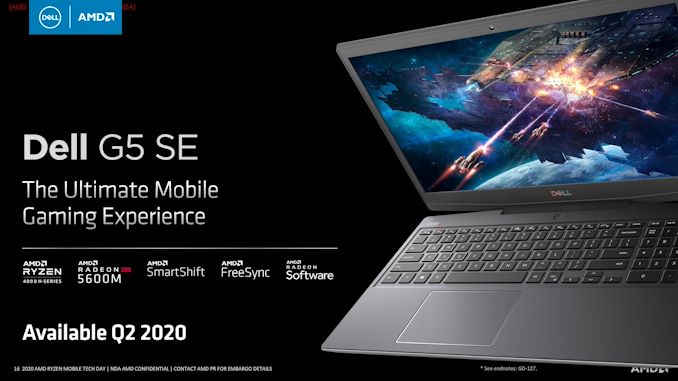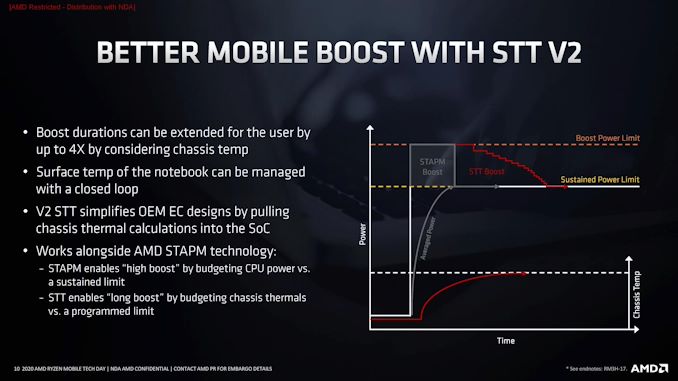AMD Details Renoir: The Ryzen Mobile 4000 Series 7nm APU Uncovered
by Dr. Ian Cutress on March 16, 2020 11:00 AM ESTAMD SmartShift
We’ve covered AMD’s SmartShift before, when it was announced at CES, as a technology that allows a system management controller to interact with both the mobile APU and an AMD graphics card in the same system in order to shift power where it is needed. This solution is still based on separate power rails between the two, however the use of the scalable control fabric (SCF) part of Infinity Fabric means that parts of the APU and parts of the GPU can interact together in this way. Ultimately AMD believes they can score 10-12% better on heavy CPU workloads like CineBench or gaming workloads like The Division.
The solution is firmware based, but requires interaction between qualified hardware. AMD states that often in these sorts of CPU+GPU designs, while the chassis has a total design TDP, if one of the elements of the system is idle, then the other can’t take advantage of the extra turbo headroom available. SmartShift aims to fix that.
What’s new here is that AMD is primarily focus will be on Ryzen Mobile 4000 + Vega 10 style systems. The first one with SmartShift enabled will be the Dell G5 SE. The Dell G5 SE is being labelled as ‘the ultimate mobile gaming experience’, and will feature a new H-series processor, the Radeon RX 5600M, SmartShift, FreeSync, and have a 15-inch display. The unit will be coming out in Q2.
System Temperature Tracking (Version 2)
SmartShift is also part of a new System Temperature Tracking paradigm that AMD is implementing in its new APUs. Even if there is power headroom, a system can’t turbo if there isn’t thermal headroom. Smart Temperature Tracing v2 (or STTv2) is designed to help a system boost for longer by knowing more about the thermal profile of the device.
My placing additional thermal probes inside the system, such as on hot controllers or discrete GPUs, the readings of these can be passed through the Infinity Fabric to an embedded management controller. Through learning how the system thermals interact when different elements are loaded, the controller can determine if the system still has headroom to stay in turbo for longer than the current methodology (AMD’s Skin Temperature Aware Power Management). This means that rather than having a small number of sensors getting a single number for the temerpature of the system, AMD takes in many more values to evaluate a thermal profile of what areas of the system are affected at what point.
What STTv2 does at the end of the day is potentially extend the boost time for a given system, depending on its thermal capabilities. For example, the Lenovo Yoga Slim 7 which we are expecting for review only has a 15 W processor inside, but the chassis has been built for a 25 W TDP design, which means that STTv2 should kick in and provide the user with peak performance for longer.














95 Comments
View All Comments
Namisecond - Thursday, March 26, 2020 - link
Yeah, so is HBM over using system memory, but we're not going to see that on the 4000-series Ryzen either.realbabilu - Tuesday, March 17, 2020 - link
Will be apple interested too?Or apple will do things like licensing from amd zen2 platform and built own system?
Cliff34 - Tuesday, March 17, 2020 - link
My only wish is that Dell put this in their xps 15. I love how much mod and customization I can do with that model.yeeeeman - Tuesday, March 17, 2020 - link
Ian, can you make, on the review on one of these puppies a test like Andrei does on phones, that is compute the efficiency using SPEC? I want to see how Ice Lake stacks up.ballsystemlord - Tuesday, March 17, 2020 - link
Spelling and grammar errors:"...with within the right thermal envelope,..."
"but" not "with":
"...but within the right thermal envelope,..."
"If the CPU went too far down this stack, while it would be saving power, each hop down the rabbit hole meant a longer time to get back out of it, diminishing performance and latency but also requiring more power changes at the silicon level."
Badly written:
"If the CPU went too far down this stack, while it would be saving power, each hop down the rabbit hole would mean a longer time to get back out of it, diminishing performance and increasing latency but also requiring more power state changes at the silicon level."
dontlistentome - Tuesday, March 17, 2020 - link
Do you think Intel will put it in a NUC for us? They can go back to 15W and quieten them down again.Tams80 - Tuesday, March 17, 2020 - link
At last, some competition.If the world hasn't gone into a massive recession it'll still be this time next year at best, likely Winter 2021, that we'll see a Ryzen 4000 CPU paired with an rDNA 2 GPU though. Ah well.
mattkiss - Tuesday, March 17, 2020 - link
Under "What's New," second paragraph:"Compared to the desktop design, the mobile is listed as being ‘optimized for mobile’, primarily by the smaller L3 cache – only 4 MB per quad-core group, rather than the 32 MB per quad-core group we see on the desktop."
Should be 16 MB per quad-core group (CCX) on the desktop, not 32.
Gondalf - Wednesday, March 18, 2020 - link
Sooo the leonovo laptop is a confirmation Renoir is a 25 W SKU, and definitevely nope a 15W class cpu. To achieve the rated clock speeds the SOC needs to increase of 70 % the TDP.This the reason Intel care nothing of these AMD SKUs, at 15W a four core cpu is much more efficient for laptop responsiveness.
TheMighty - Wednesday, March 18, 2020 - link
Nope it's a 15w chip configurable up to 25w just like intel in most cases. Nice try though.